Articles
- Page Path
- HOME > J Korean Acad Nurs > Volume 38(1); 2008 > Article
-
Original Article
- Wandering Behavior in Korean Elders with Dementia Residing in Nursing Homes
- Jun-Ah Song, Young Mi Lim, Gwi-Ryung Son Hong
-
Journal of Korean Academy of Nursing 2008;38(1):29-28.
DOI: https://doi.org/10.4040/jkan.2008.38.1.29
Published online: February 28, 2008
1Assistant Professor, College of Nursing, Korea University, Seoul, Korea.
2Associate Professor, Department of Nursing, Wonju College of Medicine, Yonsei University, Wonju, Korea.
3Associate Professor, Department of Nursing, Hanyang University, Seoul, Korea.
- Address reprint requests to: Lim, Young Mi. Department of Nursing, Wonju College of Medicine, Yonsei University, 162 Ilsan-dong, Wonju 220-701, Korea. Tel: 82-33-741-0386, Fax: 82-33-743-9490, youngmi@yonsei.ac.kr
Copyright © 2008 Korean Society of Nursing Science
Abstract
-
Purpose
- This study investigated various factors relatied to wandering behavior of Korean elders with dementia (KED).
-
Methods
- A sample of 160 ambulatory residents with dementia from 14 long term care facilities was used to examine demographic, individual, cognitive, physical health, and environmental characteristics by comparing wanderers (N=108) to nonwanders (N=52). Subjects were evaluated by Korean versions of the Mini-mental State Exam (K-MMSE), the Physical and Instrumental Activities of Daily Living (K-PIADL), and the Revised Algase Wandering Scale Nursing Home version (KRAWS-NH) along its six dimensions. Demographic and environmental data were also obtained. Independent sample t-tests, Chi-square test, Fisher's Exact tests, and ANCOVAs were used to examine differences between wanderers and nonwanders.
-
Results
- Wanderers were significantly (p<.05) older and had more limitations in K-PADL and K-IADL. The degree of overall wandering and certain features of wandering were significantly different (p<.05) by total number of residents in the facility, type of bedroom (i.e., "Ondol"), and color of bedroom and living-room walls (i.e., sky blue).
-
Conclusion
- Findings of this study may be useful in understanding wandering behavior of KEDs and thus developing more culturally specific management strategies.
This study was supported in part by the Center on Frail and Vulnerable Elders (COFVE), School of Nursing University of Michigan, pilot grant to Dr. Gwi-Ryung Son Hong.
- 1. Algase DL. Wandering in Dementia: State of Science. 1999;New York, Springer.
- 2. Algase DL, Beattie E, Song J. Differences in wandering by age, sex, race, and medical basis of dementia. In: Poster presented at the World Alzheimer Congress 2000. 2000;Washington, DC.
- 3. Algase DL, Beattie ER, Bogue EL, Yao L. The Algase Wandering Scale: initial psychometrics of a new caregiver reporting tool. Am J Alzheimers Dis Other Demen. 2001;16:141–152.ArticlePubMedPMCPDF
- 4. Algase DL, Kupferschmid B, Beel-Bates CA, Beattie ER. Estimates of stability of daily wandering behavior among cognitively impaired long-term care residents. Nurs Res. 1997;46:172–178.ArticlePubMed
- 5. Beattie ER, Song J, LaGore S. A comparison of wandering behavior in nursing homes and assisted living facilities. Res Theory Nur Pract. 2005;19:181–196.Article
- 6. Conant-Arp C, Robinson J. Long-term care design: life-enhancing design strategies at the Louis Feinstein Alzheimer day care center. J Healthc Des. 1997;9:117–120.PubMed
- 7. Cooper JK, Mungas D, Weiler PG. Relation of cognitive status and abnormal behaviors in Alzheimer's disease. J Am Geriatr Soc. 1990;38:867–870.ArticlePubMed
- 8. Everitt DE, Field CM, Soumerai SS, Avorn J. Resident behavior and staff distress in the nursing home. J Am Geriatr Soc. 1991;38:792–798.
- 9. Hope T, Tilling KM, Gedling K, Keene JM, Cooper SD. The structure of wandering in dementia. Int J Geriatr Psychiatry. 1994;9:149–155.Article
- 10. Hussian RA. Geriatric Psychology: A Behavioral Perspective. 1981;New York, Van Nostrand Reinhold Co.
- 11. Kang Y, Na DL, Hahn S. A validity study on the Korean Mini-mental State Examination (K-MMSE) in dementia patients. J Korean Neurol Assoc. 1997;15:300–308.
- 12. Kim JH, Lee CE. A study on the problem behaviors according to characteristics of dementia elderly. J Korean Gerontol Nurs. 2000;2:176–183.
- 13. Kim TH, Jun GY. A study on caregiving situations and resources for adjustment among family caregivers of the elderly with dementia. J Korean Home Econom Assoc. 1996;34:145–160.
- 14. Kiely DK, Morris JN, Algase DL. Residents characteristics associated with wandering in nursing homes. Int J Geriatr Psychiatry. 2000;15:1013–1020.PubMed
- 15. The results of special estimation of future population. Korean Statistical Office. 2005;Retrieved August 10, 2007, from Korea national statistical office Web site: http://www.nso.go.kr.htm.
- 16. Kwon JD. Development of the Measurement tool and model for the caregiving. 1995;Seoul, Hongikjae.
- 17. Lee BW, Park JS. A study on the color planning of facilities for the elderly as an environmental element. J Korean Inst Healthc Archit. 1997;3(5):53–66.
- 18. Lezak MD. Neuropsychological Assessment. 1995;3rd ed. Oxford University Press.
- 19. Medicity website. Retrieved August 10, from https://www.medcity.com/zboard/zboard.php?id=chimae&no=514.
- 20. Nelson J. The influence of environmental factors in incidents of disruptive behavior. J Gerrontol Nurs. 1995;21(5):19–24.Article
- 21. Price JD, Hermans DG, Evans G. Subjective barriers to prevent wandering of cognitively impaired people. Cochrane Database of Systematic Reviews. 2000;(1):CD001932.
- 22. Rowe MA, Glover JC. Antecedents, descriptions and consequences of wandering in cognitively-impaired adults and the Safe Return (SR) program. Am J Alzheimers Dis Other Demen. 2001;16:344–352.ArticlePubMedPMCPDF
- 23. Sloane PD, Mitchell M, Preisser JS, Phillips C, Commander C, Burker E. Environmental correlates of resident agitation in Alzheimer's disease special care units. J Am Geriatr Soc. 1998;46:862–869.ArticlePubMed
- 24. Song J. Relationship of premorbid personality and behavioral responses to stress to wandering behavior of residents with dementia in long term care facilities. 2003;University of Michigan. Unpublished doctoral dissertation.
- 25. Song W, Joo JH, Park JS. A study on the architectural planning of the physical environment of the dementia ward. J Korean Inst Healthc Archit. 1999;5(8):33–41.
- 26. Struble LM. Ambulation behaviors of people with Alzheimer's disease: Case studies of residents in three facilities along the homelike continuum. 1995;University of Michigan. Unpublished doctoral dissertation.
- 27. Thomas DW. Understanding the wandering patient: a continuity of personality perspective. J Gerontol Nurs. 1997;23(1):16–24.Article
- 28. Tumbull G. Features: the bottom line on wandering and elopement. Extended Care Product News. 2002;83(5):20–21.
- 29. Yao L, Algase D. Environmental ambiance as a new window on wandering. West J Nurs Res. 2006;28(1):89–104.ArticlePubMedPDF
- 30. Yu YM. A study on the architectural planning of skilled nursing homes for the elderly. J Korean Inst Healthc Archit. 1999;5(9):97–106.
REFERENCES
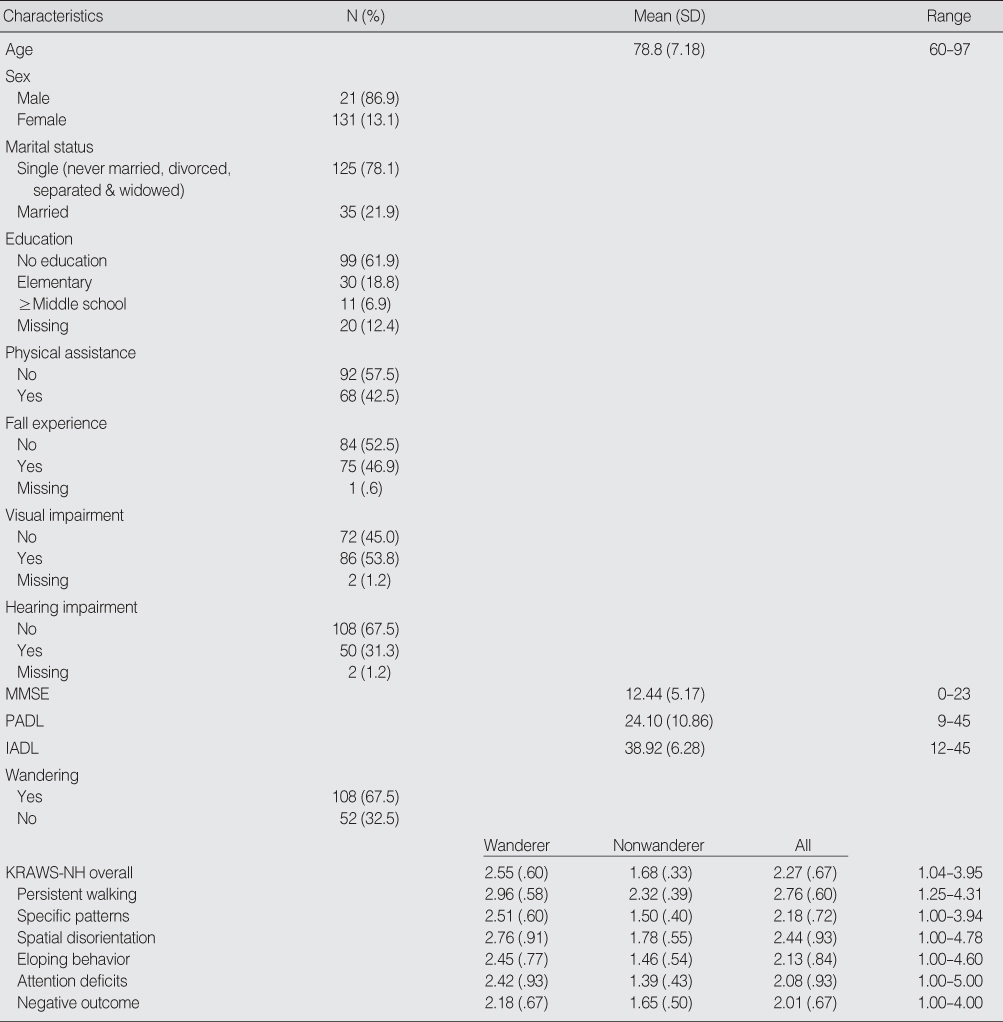
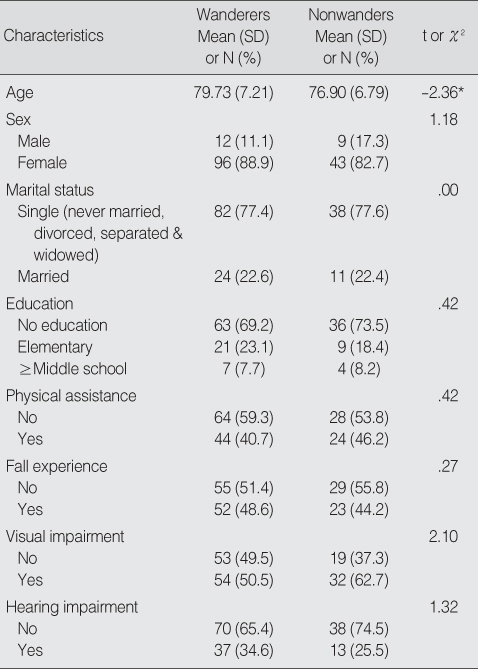
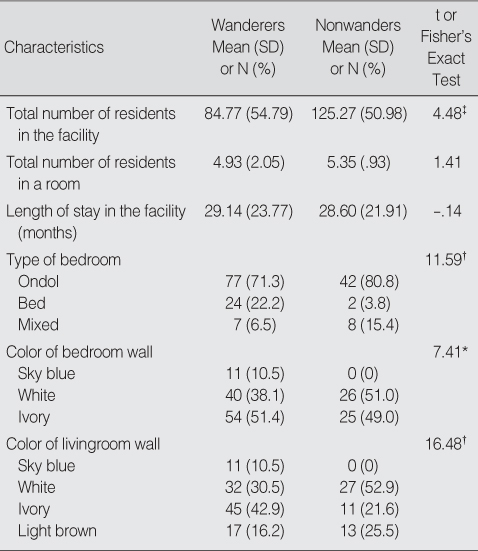
Figure & Data
REFERENCES
Citations

- Risk Factors Associated with Missing Incidents among Persons Living with Dementia: A Scoping Review
Hector Perez, Antonio Miguel Cruz, Noelannah Neubauer, Christine Daum, Aidan K. Comeau, Samantha Dawn Marshall, Elyse Letts, Lili Liu
Canadian Journal on Aging / La Revue canadienne du vieillissement.2024; 43(3): 370. CrossRef - Non-pharmacological Intervention for Wandering Behavior in Dementia: A Systematic Review and Meta-analysis
Yoojin Kim, Eunhee Cho
Journal of Korean Gerontological Nursing.2022; 24(3): 321. CrossRef - A Relationship between Depression and Wandering in Community-Dwelling Elders with Dementia
Jae Gwon Jeong, Jun Ah Song, Kun Woo Park
Dementia and Neurocognitive Disorders.2016; 15(1): 1. CrossRef - Validation of the Measure of Unmet Need For Dementia Family Caregivers For Korean Sample
Kyeonga Yoon, 손의성
Korean Journal of Gerontological Social Welfare.2015; null(70): 197. CrossRef - The Long-term Care Utilization of the Elderly with Dementia, Stroke, and Multimorbidity in Korea
Boyoung Jeon, Soonman Kwon, Hongsoo Kim
Health Policy and Management.2013; 23(1): 90. CrossRef - Development and Evaluation of a Dysphagia Assessment Tool and an Intervention Program for the Elderly in the Long-Term Care Facilities
Chi-Young Kim, Young-Mi Lee, Eun-Ho Ha
Journal of the Korea Academia-Industrial cooperation Society.2012; 13(2): 685. CrossRef - Relationship between familiar environment and wandering behaviour among Korean elders with dementia
Gwi‐Ryung Son Hong, Jun‐Ah Song
Journal of Clinical Nursing.2009; 18(9): 1365. CrossRef - Validity and Reliability of the Korean Version of the Observable Indicators of Nursing Home Care Quality Evaluation Instrument
Jia Lee
Journal of Korean Academy of Nursing.2008; 38(3): 474. CrossRef
Demographic, Personal, Cognitive, and Physical Characteristics and Wandering Behavior in Elders with Dementia residing in Nursing Homes (N=160)
MMSE=Mini-mental State Exam; PADL=Physical Activities of Daily Living; IADL=Instrumental Activities of Daily Living; KRAWS-NH=Korean version of the Revised Algase Wandering Scale Nursing Home version.
Comparison of Demographic, and Personal Characteristics between Wanderers (N=108) and Nonwanderers (N=52)
missing data excluded. *p<.05.
Comparison of Cognitive and Physical functions between Wanderers and Nonwanderers
missing data excluded. *p<.05; †p<.01; ‡p<.001. MMSE=Mini-mental State Exam; PADL=Physical Activities of Daily Living; IADL=Instrumental Activities of Daily Living.
Comparison of Environmental Characteristics between Wanderers (N=108) and Nonwanderers (N=52)
missing data excluded. *p<.05; †p<.01; ‡p<.001.
Comparison of KRAWS-NH Overall and Subscale Scores by Environmental Characteristics, Controlling for Subject's Age, Physical ADL, and Instrumental ADL
missing data excluded. *p<.05; †p<.01; ‡p<.001. KRAWS-NH=Korean version of the Revised Algase Wandering Scale Nursing Home version; ADL=Activities of Daily Living.
MMSE=Mini-mental State Exam; PADL=Physical Activities of Daily Living; IADL=Instrumental Activities of Daily Living; KRAWS-NH=Korean version of the Revised Algase Wandering Scale Nursing Home version.
missing data excluded. *p<.05.
missing data excluded. *p<.05; †p<.01; ‡p<.001. MMSE=Mini-mental State Exam; PADL=Physical Activities of Daily Living; IADL=Instrumental Activities of Daily Living.
missing data excluded. *p<.05; †p<.01; ‡p<.001.
missing data excluded. *p<.05; †p<.01; ‡p<.001. KRAWS-NH=Korean version of the Revised Algase Wandering Scale Nursing Home version; ADL=Activities of Daily Living.
 KSNS
KSNS
 E-SUBMISSION
E-SUBMISSION
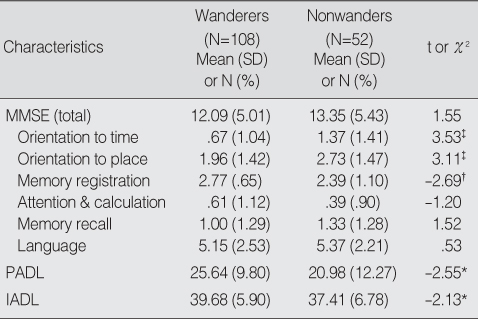
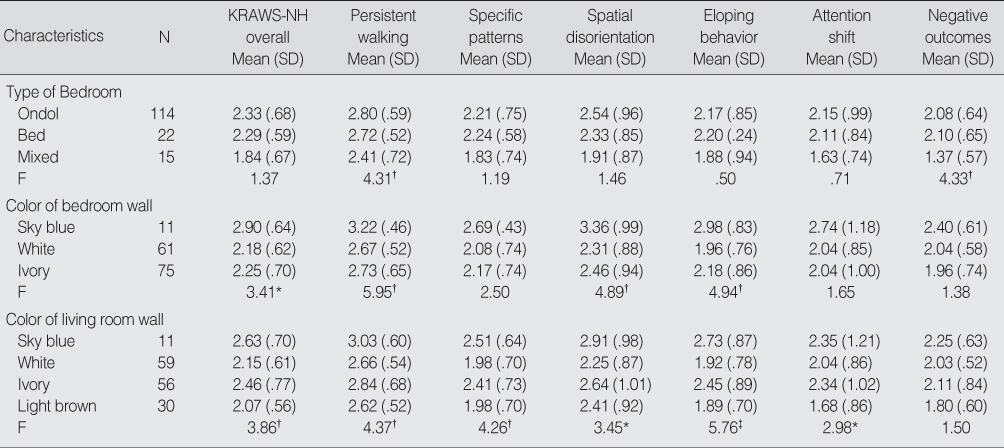
 Cite
Cite

